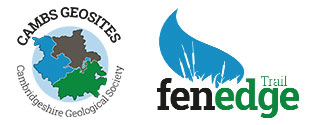

Field Trip Report
Burwell Local Geological Sites
On a sunny morning on the 5th June, 16 participants met at the Guildhall in Burwell for an introduction by Reg Nicholls (leader) to the geological and palaeoclimate background to the Cretaceous exposures to be visited.
First stop was over the scarp edge down to the spring in the Castle grounds. The springs were flowing copiously and visibly from the junction of the West Melbury Chalky Marl and the Totternhoe Stone – both rocks showing as outcrop. The exposure is very weathered, making a visual segregation difficult.
After a look at the remains of the castle site, we walked back up past the Guildhall (identifying a Terebratulid brachiopod and a bivalve fragment in the clunch walls) and through St Mary’s churchyard past the memorial gravestone to the Burwell Barn fire of 1727, to the church building itself.
We paused to look at the composition of the walls – mostly flint and a few exotic field stones together with Linconshire limestone quoins and decorative work.

The group “socially distancing” around the Spring site
Photo: Angela Bellis

Close up examination of the Zig Zag Chalk in Carter’s Pit
Carter’s Pit is one of the few remaining visible quarry faces left in the area: the party made its way along the path into the pit to stand and view the expanse of exposed Chalk quarry face. The Chalk is very weathered and is thought to be representing mostly the Zig Zag Chalk, with perhaps the underlying (better quality) Totternhoe Stone at its base. After some discussion about where the junction might be, we made our way back out past a well on the edge of the quarry, out of the pit.
Further information on these sites can be found here, here and here.